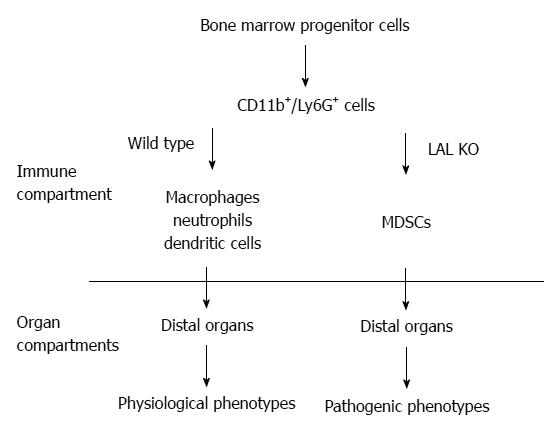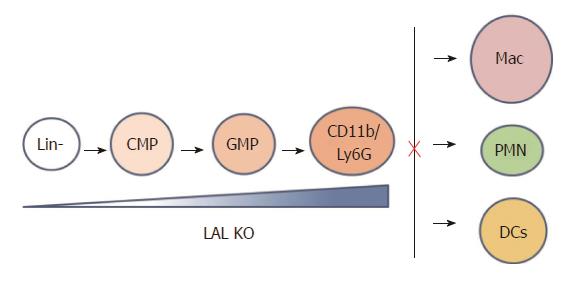Copyright
©2014 Baishideng Publishing Group Inc.
Figure 1 The functional role of Lysosomal acid lipase in myeloid lineage cells.
In the wild type mice, the CD11b+Ly6G+ cells are myeloid lineage precursors for monocytes/macrophages, neutrophils, and dendritic cells, which participate in the normal physiological functions of the distal organs (e.g., lung, liver, etc.), such as clearance of invading pathogens. The lysosomal acid lipase (LAL) activity is essential for normal myeloid lineage cell development, differentiation and function. LAL deficiency leads to neutral lipid accumulation in myeloid cells and blocks CD11b+Ly6G+ cells from further differentiation into mature myeloid lineage cells. The accumulated CD11b+Ly6G+ cells possess various malfunctions that participate in the pathogenic conditions in the residing organs. MDSCs: Myeloid-derived suppressive cells.
Figure 2 Lysosomal acid lipase is required for normal myeloid lineage cell development and differentiation.
Lysosomal acid lipase (LAL) deficiency leads to increased myeloid-derived suppressive cells differentiation from Lin- progenitor cells in the bone barrow, and decreased differentiation to mature macrophages, neutrophils, and dendritic cells in other compartments. Lin-: Lineage negative progenitor; CMP: Common myeloid progenitor; GMP: Granulocyte-macrophage progenitor; Mac: Macrophage; PMN: Polymorphonuclear cell, or neutrophil; DC: Dendritic cell.
Figure 3 Lysosomal acid lipase is required for normal T cell development and differentiation.
Lysosomal acid lipase (LAL) deficiency can cause the intrinsic defect in T cell development, starting at the double negative 3 (DN3) stage. In addition, myeloid-derived suppressive cells infiltrate into the thymus and spleen, resulting in blockage of normal T cell development, differentiation, and maturation. DN: CD4 and CD8 double negative; DP: CD4 and CD8 double positive; SP: CD4 or CD8 single positive.
Figure 4 Lysosomal acid lipase deficiency induces overactivation of the mTOR pathway in myeloid-derived suppressive cells.
Lysosomal acid lipase (LAL) is a lysosome-associated enzyme. LAL deficiency increases mTOR complexes anchoring on lysosomes and stimulates the mTOR1 activity to influence the cellular metabolism and proliferation of lal-/- myeloid-derived suppressive cells (MDSCs). These include an increased influx of glucose through aerobic glycolysis, an increased mitochondrial oxidative phosphorylation and ATP production, an impairment of the mitochondrial membrane potential in association with increased reactive oxygen species (ROS) production, and an increased cell cycle entry in lal-/- MDSCs.
Figure 5 Lysosomal acid lipase and its downstream effector genes.
Lysosomal acid lipase (LAL) cleaves cholesteryl esters (CE) and triglycerides (TG) to produce free cholesterol (FC) and fatty acids (FFA) in lysosomes of cells. The lipid derivatives (9-HODE, 13-HODE) of FFA serve as ligands for PPARγ in coupling with retinoid X receptor α (RXRα, which suppresses gene expression of a variety of pro-inflammatory cytokines. The LAL/PPARγ axis serves as an anti-inflammatory pathway. LAL deficiency blocks this metabolic pathway to provoke up-regulation of pro-inflammatory cytokines (e.g., Api6, MMP12). TGF: Transforming growth factor beta; IL: Interleukin; MCP: Monocyte chemotactic protein; TNF: Tumor necrosis factor; NF: Nuclear factor.
- Citation: Yan C, Du H. Lysosomal acid lipase is critical for myeloid-derived suppressive cell differentiation, development, and homeostasis. World J Immunol 2014; 4(2): 42-51
- URL: https://www.wjgnet.com/2219-2824/full/v4/i2/42.htm
- DOI: https://dx.doi.org/10.5411/wji.v4.i2.42













